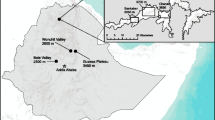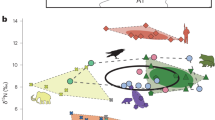Abstract
Belowground plant parts were important potential food resources in the habitats associated with Pliocene and early Pleistocene hominids. The food gathering and dental adaptations of three groups of modem mammals — bears, pigs, and humans — testify to the earlier convergence of these animals on this resource. Since belowground food reserves are relatively unaffected by the factors controlling aboveground food supply (fire, drought, and grazing stress), exploitation of this stable nutritional bank had distinct energetic and behavioral advantages for hominids.
Similar content being viewed by others
References
Andrews, P., and Nesbit Evans, E. (1979). The environment ofRamapithecus in Africa.Paleobiology 5(1): 22–30.
Andrews, P., and Van Couvering, J. A. H. (1975). Palaeoenvironments in the East African Miocene. In Szalay, F. S. (ed.),Approaches to Primate Paleobiology, Contributions to Primatology, Vol. 5, Karger, Basel, pp. 62–103.
Annual Report, Interagency Study Team (1977).Yellowstone Grizzly Bear Investigations. U.S. National Park Service, Washington, D.C.
Behrensmeyer, A. K. (1975). Taphonomy and paleoecology in the hominid fossil record.Yearbook of Physical Anthropology 19: 38–50.
Behrensmeyer, A. K. (1976). Fossil assemblages in relation to sedimentary environments in the East Rudolf succession. In Coppens, Y., Howell, F. C., Isaac, G. Ll., and Leakey, R. E. F. (eds.),Earliest Man and Environments in the Lake Rudolf Basin, University of Chicago Press, Chicago, pp. 383–401.
Bell, R. H. V. (1971). A grazing ecosystem in the Serengeti.Scientific American 225: 86–93.
Bennett, L. J., English, P. F., and Watts, R. L. (1943). The food habits of the black bear in Pennsylvania.Journal of Mammalogy 24(1): 25–31.
Berggren, W. A., and Van Couvering, J. A. (1974). The late Neogene: Biostratigraphy, geochronology and paleoclimatology of the last 15 million years in marine and continental sequences.Paleogeography, Paleoclimatology, Paleoecology 16(1–2): 1–216.
Bergman, S. (1936). Observations on the Kamchatkan bear.Journal of Mammalogy 17(2): 115–120.
Bonnefille, R. (1976). Palynological evidence for an important change in the vegetation of the Omo Basin between 2.5 and 2 million years ago. In Coppens, Y., Howell, F. C., Isaac, G. Ll., and Leakey, R. E. F. (eds.),Earliest Man and Environments in the Lake Rudolf Basin, University of Chicago Press, Chicago, pp. 421–432.
Carr, C. J. (1976). Plant ecological variation and pattern in the Lower Omo Basin. In Coppens, Y., Howell, F. C., Isaac, G. Ll., and Leakey, R. E. F. (eds.),Earliest Man and Environments in the Lake Rudolf Basin, University of Chicago Press, Chicago, pp. 432–471.
Cartmill, M. (1974).Daubentonia, Dactylopsila, woodpeckers and klinorhynchy. In Martin, R. P., Doyle, G. A., and Walker, A. C. (eds.),Prosimian Biology, University of Pittsburgh Press, Pittsburgh, pp. 655–670.
Chew, R. M. (1974). Consumers as regulators of ecosystems.Ohio Journal of Science 74(6): 359–370.
Cooke, H. B. S. (1978). Suid evolution and correlation of African hominid localities: An alternative taxonomy.Science 201: 460–463.
Cooke, H. B. S., and Wilkinson, A. F. (1978). Suidae and Tayassuidae. In Maglio, V. J., and Cooke, H. B. S. (eds.),Evolution of African Mammals, Harvard University Press, Cambridge, Mass., pp. 435–482.
Coupland, R. T. (1979). Conclusion. In Coupland, R. T. (ed.),Grassland Ecosystems of the World: Analysis of Grasslands and Their Uses, Cambridge University Press, Cambridge pp. 335–355.
Coursey, D. G. (1972). The civilizations of the yam: Interrelationships of man and yams in Africa and the Indo-Pacific region.Archaeology and Physical Anthropology in Oceania 7(3): 215–233.
Coursey, D. G. (1973). Hominid evolution and hypogeous plant foods.Man (n.s.) 8: 634–635.
Coursey, D. G., and Booth, R. H. (1977). Root and tuber crops. In Leakey, C. L. A. (ed.),Food Crops of the Lowland Tropics, Oxford University Press, Oxford, pp. 75–95.
Craighead, J. J., and Craighead, F. G. (1971). Grizzly bear-man relationships in Yellowstone National Park.Bioscience 21(16): 845–857.
Crompton, A. W., and Hiiemäe, K. (1969). How mammalian molar teeth work.Discovery (Yale) 5(1): 23–34.
Daubenmire, R. (1968). Ecology of fire in grasslands.Advances in Ecological Research 5: 209–273.
Detling, J., Dyer, M. I., and Winn, D. T. (1979). Net photosynthesis, root respiration and regrowth ofBouteloua gracilis following simulated grazing.Oecologia (Berlin) 41: 127–134.
Dorst, J. (1969).A Field Guide to the Larger Mammals of Africa. Houghton Mifflin, Boston.
Dunbar, R. I. M. (1976). Australopithecine diet based on a baboon analogy.Journal of Human Evolution 5: 161–167.
Dyer, M. I. (1979). Natural temperature grasslands: Consumers. In Coupland, R. T. (ed.),Grassland Ecosystems of the World: Analysis of Grasslands and Their Uses, Cambridge University Press, Cambridge, pp. 73–87.
Dykojová, R., and Kvet, J. (1975). Primary data on biomass and production estimates. In Hasler, A. D. (ed.),Coupling of Land and Water Systems. Springer-Verlag, New York, pp. 1–21.
Ellison, L. (1960). The influence of grazing on plant succession of rangelands.Botanical Review 26: 1–66.
Elman, R. (1974).The Hunter's Field Guide. Alfred A. Knopf, New York.
Every, R. G. (1970). Sharpness of teeth in man and other primates.Postilla 143: 1–30.
Field, C. R. (1970). Observations on the food habits of tame warthog and antelope in Uganda.East African Wildlife Journal 8: 1–17.
Galdikas, B. M. F. (1978). Orangutan death and scavenging by pigs.Science 200: 68–70.
Gaulin, S. J. C. (1979). A Jarman/Bell model of primate feeding niches.Human Ecology 7(1): 1–20.
Geist, V. (1974). On the relationship of social evolution and ecology in ungulates.American Zoologist 14: 205–220.
Geist, V. (1978).Life Strategies, Human Evoluion, Environmental Design. Springer-Verlag, New York.
Gregory, W. K. (1922).The Origin and Evolution of the Human Dentition. Williams and Wilkins, Baltimore.
Gregory, W. K., and Hellman, M. (1923a). Notes on the type ofHesperopithecus haroldcookii Osborn.American Museum Novitates No. 53.
Gregory, W. K., and Hellman, M. (1923b). Further notes on the molars ofHesperopithecus andPithecanthropus. Bulletin of American Muscum of National History XLVIII, Article VIII: 509–526.
Hamilton, W. J., III, Buskirk, R. E., and Buskirk, W. H. (1978). Omnivory and utilization of food resources by Chacma baboons,Papio ursinus. American Naturalist 112(987): 911–924.
Harris, J. M., and White, T. D. (1979). Evolution of the Plio-Pleistocene African suidae.Transactions of the American Philosophical Society 69(2).
Hay, R. L. (1976). Environmental settings of hominid activities at Bed I, Olduvai. In Issac, G. Ll., and McCown, E. R. (eds.),Human Origins. Louis Leakey and the East African Evidence, W. A. Benjamin, Menlo Park, Calif., pp. 209–225.
Heinz, H. J., and Maguire, B. (1976) The ethno-biology of the !kõ Bushman: Their ethnobotanical knowledge and plant lore.Botswana Society, Occasional Paper No. 1. Government Printer, Gaborone, 53 pp.
Hutchinson, G. E. (1975).A Treatise on Limnology, Vol. 3,Limnological Botany. Wiley, New York.
Isaac, G. Ll. (1972). Comparative studies of Pleistocene site locations in East Africa. In Ucko, P. J., and Dimbleby, G. W. (eds.),Man, Settlement and Urbanism. Duckworth, London, pp. 165–176.
Isaac, G. Ll. (1976). The activities of early African hominids. In Isaac, G. Ll., and McCown, E. R. (eds.),Human Origins. Louis Leakey and the East African Evidence, W. A. Benjamin, Menlo Park, Calif., pp. 483–514.
Isaac, G. Ll. (1978). The food-sharing behavior of protohuman hominids.Scientific American 56: 90–105.
Jarman, P. J. (1974). The social organization of antelope in relation to their ecology.Behavior V(XLVIH pt. 3–4): 215–267.
Jolly, A. (1972).The Evolution of Primate Behavior. Macmillan, New York.
Jolly, C. J. (1970). The seed eaters: A new model of hominid differentiation based on a baboon analogy.Man (n.s.) 5: 5–26.
Jonkel, C. J., and McT. Cowan, I. (1971). The black bear in the Spruce-Fir forest.Wildlife Monographs. Wildlife Society, Washington, Publ. No. 27.
Kay, R. F. (1975). Allometry and early hominids.Science 189: 63.
Kurtén, B. (1968).Pleistocene Mammals of Europe. Aldine, Chicago.
Leakey, M. D. (1971).Olduvai Gorge, Vol. III,Excavations in Beds I and II, 1960–1963. Cambridge University Press, Cambridge.
Leister, C. W. (1939). The wild pigs of the world.Bulletin of the New York Zoological Society 42(5): 130–139.
Mann, A. (1972). Hominid and cultural origins.Man (n.s.) 7: 379–386.
McNab, B. K. (1963). Bioenergetics of home range size.American Naturalist 894: 133–140.
McNaughton, S. J. (1976). Serengeti migratory Wildebeest: Facilitation of energy flow by grazing.Science 191: 92–94.
Mitchell, D. S. (1978). Freshwater plants. In Werger, M. J. A. (ed.),Biogeography and Ecology of Southern Africa, Vol. II, W. Junk, The Hague.
Murie, A. (1937). Some food habits of the black bear.Journal of Mammalogy 18(2): 238–240.
Murphey, P. G. (1975). Net primary productivity in tropical terrestrial ecosystems. In Whittaker, R. H. (ed.),Primary Productivity of the Biosphere, Springer-Verlag, New York.
Noy-Meir, I. (1973). Desert ecosystems: Environment and producers.Annual Review of Ecology and Systematics 4: 25–52.
Owen, D. F., and Wiegert, R. G. (1976). Do consumers maximize plant fitness?Oikos 27: 488492.
Peterides, G. A. (1974). The overgrazing cycle as a characteristic of tropical savanahs and grasslands in Africa. InProceedings of the First International Congress of Ecology, The Hagne, pp. 86–91.
Peters, C. R. (1979). Toward an ecological model of African Plio-Pleistocene hominid adaptations.American Anthropologist 81: 261–278.
Piecgynska, E. (1975). Interactions between land and littoral zones. In Hasler, A. D. (ed.),Coupling of Land and Water Systems, Springer-Verlag, New York, pp. 263–274.
Pilbeam, D. R. (1972).The Ascent of Man. Macmillan, New York.
Romer, A. L. (1966).Vertebrate Paleontology. University of Chicago Press, Chicago.
Schmidt-Nielson, K. (1979).Animal Physiology: Adaptation and Environment, Cambridge University Press, Cambridge.
Simons, E. L. (1972).Primate Evolution. Macmillan, New York.
Simpson, G. G. (1944).Tempo and Mode of Evolution. Columbia University Press, New York.
Simpson, G. G. (1953).The Major Features of Evolution. Simon and Schuster, New York.
Stanley, S. (1973). An explanation for Cope's Rule.Evolution 27: 1–26.
Stegeman, L. C. (1938). The European wild boar in the Cherokee National Forest, Tennessee.Journal of Mammalogy 19(3): 279–290.
Stoddart, L. A., Smith, D., and Box, T. (1975).Range Management, 3rd ed. McGraw-Hill, New York.
Szalay, F. S. (1975). Hunting-scavenging protohominids: A model for hominid origins.Man (n.s.) 10: 420–429.
Tanaka, J. (1976). Subsistence ecology of Central Kalahari San. In Lee, R. B., and Devore, I. (eds.),Kalahari Hunter-Gatherers: Studies on the !Kung San and Their Neighbors, Cambridge: Harvard University Press, Cambridge, Mass., pp. 98–119.
Trlica, M. J. (1977). Distribution and utilization of carbohydrate resources in range plants. In Sosebbe, R. (ed.),Rangeland Plant Physiology, Society for Range Management, Denver, Range Science Series No. 4: 258–290.
Van Couvering, J. A. H. (1976). Community evolution and succession in East Africa during the Late Cenozoic. Paper prepared for “Taphonomy and Vertebrate Paleoecology: With special reference to the Late Cenozoic of Sub-Saharan Africa.” Manuscript.
Van Rensberg, V. H. J. (1971). Fire: Its effects on grasslands, including swamps. In Komarek, E. V. (ed.),Fire in Africa, Proceedings of the Annual Tall Timber Fire Ecology Conference No. 11, Tallahassee, pp. 175–199.
Vaughan, T. A. (1972).Mammalogy. W. B. Saunders, Philadelphia.
Vesey-Fitzgerald, L. (1965). The utilization of natural pastures in the Rukwa Valley, Tanganyika.East African Wildlife Journal 3: 38–48.
von Wahlert, G. (1965). The role of ecological factors in the origin of higher levels of organization.Systematic Zoology 14: 288–300.
Walker, A. (1979). S.E.M. analysis of microwear and its correlation with dietary patterns.American Journal of Physical Anthropology 50: 489.
Walker, E. P. (1975).Mammals of the World. The Johns Hopkins Univeristy Press, Baltimore.
White, T. D., and Harris, J. M. (1977). Suid evolution and correlations of African hominid localities.Science 198: 13–21.
Whittaker, R. H. (1970).Communities and Ecosystems. Macmillan, New York.
Wolpoff, M. H. (1973). Posterior tooth size, body size, and diet in South African gracile australopithecines.American Journal of Physical Anthropology 39: 375–394.
Author information
Authors and Affiliations
Rights and permissions
About this article
Cite this article
Hatley, T., Kappelman, J. Bears, pigs, and Plio-Pleistocene hominids: A case for the exploitation of belowground food resources. Hum Ecol 8, 371–387 (1980). https://doi.org/10.1007/BF01561000
Issue Date:
DOI: https://doi.org/10.1007/BF01561000




